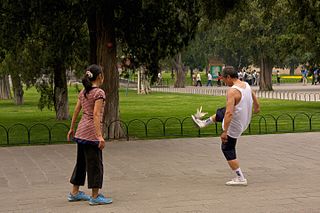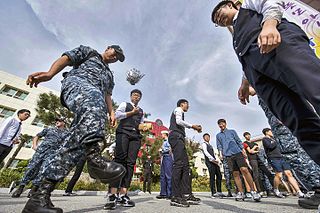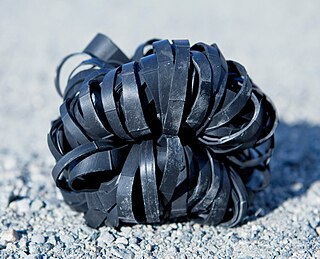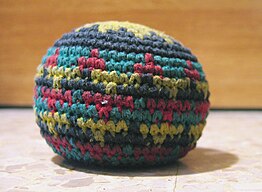
A first baseman, abbreviated 1B, is the player on a baseball or softball team who fields the area nearest first base, the first of four bases a baserunner must touch in succession to score a run. The first baseman is responsible for the majority of plays made at that base. In the numbering system used to record defensive plays, the first baseman is assigned the number 3.

Jianzi, tī jianzi (踢毽子), tī jian (踢毽), or jianqiú (毽球), is a traditional Chinese sport in which players aim to keep a heavily weighted shuttlecock in the air using their bodies apart from the hands, unlike in similar games such as peteca and indiaca. The primary origin of jianzi is an ancient Chinese game called Cuju, from the Han dynasty, 2,000 years ago. Jianzi is played on a badminton court using inner or outer lines in different competition settings. It can also be played artistically, among a circle of players in a street or park, with the objective to keep the shuttle 'up' and show off skills. In Vietnam, it is known as đá cầu, and it is the national sport. In the Philippines, it is known as sipa and was also the national sport, until it was replaced by arnis in December 2009.

Sipa is the Philippines' traditional native sport which predates the Spanish rule. The game is related to Sepak Takraw. Similar games include Footbag net, Footvolley, Bossaball and Jianzi.

Freestyle football is the art of juggling a football using any part of the body, excluding the elbows to the hands. It combines football tricks, dance, acrobatics and music to entertain onlookers and compete with opponents. The official governing body for this sport is known as the World Freestyle Football Association (WFFA).
A freestyle skateboarding trick is a trick performed with a skateboard while freestyle skateboarding. Some of these tricks are done in a stationary position, unlike many other skateboarding tricks. The keys to a good freestyle contest run are variety, difficulty, fluidity, and creativity. This is an incomplete list, which includes most notable tricks.
Freestyle Footbag is a footbag sport where players demonstrate their abilities by performing sequences of acrobatic tricks. The ending position of the bag on one trick becomes the starting position of the bag on the next trick. Tricks are created by combining different components between contacts. Components can be spins, dexterities, or ducks. Contacts are usually on the inside of the foot behind the opposite support leg or on the toe, however many inventive possibilities remain and are used to create a near-endless list of tricks.
Traditional Filipino games or indigenous games in the Philippines are games that are played across multiple generations, usually using native materials or instruments. In the Philippines, due to limited resources for toys, children usually invent games that do not require anything but players. There are different kinds of Filipino traditional games which are well-suited for kids, and the games also stand as one of the different cultural and traditional games of the Philippines. Due to the variety of skills used in these games, they serve an important purpose in the physical and mental development of Filipino children. These games are also an important part of Filipino culture.
Mike Marshall was an American inventor best known for his co-invention, with John Stalberger, of the sport footbag and the Hacky Sack in 1972. Marshall was living in Oregon when he met Stalberger. Stalberger was undergoing rehabilitation for his knee and so he began to exercise with Marshall, who was kicking around a homemade beanbag.
Hack slap is a game that utilises a footbag or 'Hacky Sack'. The game is similar to the Australian handball rules
This is a general glossary of the terminology used in the sport of rugby union. Where words in a sentence are also defined elsewhere in this article, they appear in italics.

A hand sack is any sack or similar object, typically made of cloth and filled with sand or a similar material, that is tossed on the back of the hand for the purpose of mastering tricks or playing games.

A shove-it is a skateboarding trick where the skateboarder makes the board spin 180 degrees without the tail of the board hitting the ground under their feet. There are many variations of the shove-it but they all follow the same principle: The skateboarder's lead foot remains in one spot, while the back foot performs the "shove". The pop shove-it was originally called a "Ty hop", named after Ty Page.

A bean bag is a sealed bag containing dried beans, PVC pellets, expanded polystyrene, or expanded polypropylene. The bags are commonly used for throwing games, but they have various other applications.

Jegichagi is a Korean traditional outdoor game in which players kick a paper jegi into the air and attempt to keep it aloft. A jegi is similar to a shuttlecock, and is made from paper wrapped around a small coin.

Basse is a Norwegian ball game, with roots before World War I. Today basse is mostly played in the county of Trøndelag, but has also spread to other countries.

In association football, shooting is hitting the ball in an attempt to score a goal. It is usually done using the feet or head. A shot on target or shot on goal is a shot that enters the goal or would have entered the goal if it had not been blocked by the goalkeeper or another defensive player.
The following outline is provided as an overview of and topical guide to association football:

Traditional games of Korea have been influenced by the culture, history and environment of Korea. Examples of popular traditional games include jegichagi, neolttwigi, ssireum, tuho, and yut.

















